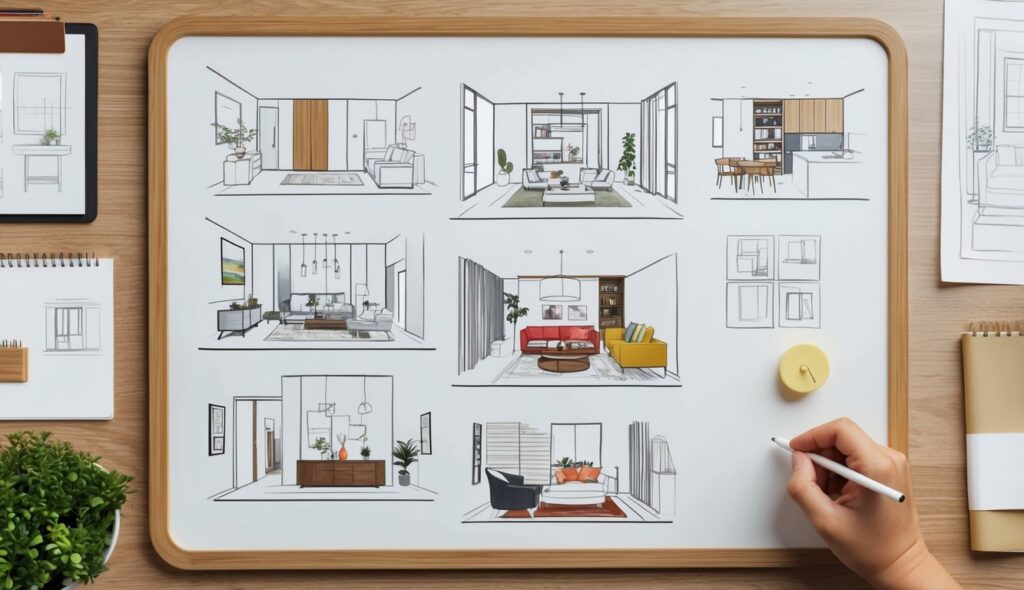Teak wood has long been a staple in both architecture and furniture design, celebrated for its robustness and aesthetic appeal. The natural oils present in teak make it resistant to weather and pests, making it an ideal choice for sustainable and long-lasting furniture.
Remember to repin your favorite images!
This material not only enhances the functional aspects of furniture but also elevates the visual appeal, contributing to the overall design integrity of architectural projects.
Incorporating teak into modernist architectural projects, such as the renowned Case Study Houses, showcases the versatility and elegance of this material.
The Eames House, a celebrated example, integrates teak furniture seamlessly into its living spaces, embodying both form and function.
Pieces like minimalist teak chairs and tables amplify the airy, open-concept designs quintessential to mid-century modern aesthetics, emphasizing a cohesive and harmonious living environment.
Architects have also been drawn to teak for its capacity to be hand-sculpted into intricate furniture designs.
These designs maintain a sophisticated balance between geometric rigor and organic fluidity.
Projects like Pierre Koenig’s Stahl House illustrate how teak furniture can complement steel and glass frameworks, adding warmth and texture without detracting from the modernist ethos.
Historical Evolution of Teak in Architecture
Teak has always been valued for its durability and beauty. It has played a significant role in shaping modern architectural and design practices, influencing both furniture and larger structural elements.
The Emergence of Teak Furniture in Modern Design
The mid-20th century saw a rise in the use of teak, particularly in mid-century modern design. This era favored clean lines and functionality, attributes that teak exemplifies.
Designers like Mies van der Rohe and Marcel Breuer utilized teak not only for its strength but also for its warm, appealing aesthetic.
The material’s ability to be carved into intricate forms made it a favorite for modern and contemporary furnishings.
Teak’s resistance to weathering also made it a desirable choice for both indoor and outdoor furniture.
Furniture pieces like the Barcelona chair often incorporated teak to fuse modern materials with timeless appeal.
This combination of durability and elegance pushed teak to the forefront of architectural design.
Iconic Teak Pieces and Their Creators
Many influential architects and designers have contributed to the legacy of teak in modern architecture.
Mies van der Rohe’s collaboration with Lilly Reich resulted in the creation of the Barcelona chair, which often featured teak.
Marcel Breuer’s Wassily Chair is another iconic piece that demonstrates the versatility of teak in creating groundbreaking designs.
Le Corbusier and Charlotte Perriand also played pivotal roles in integrating teak into their projects, emphasizing minimalism and functional beauty.
These designers recognized teak’s potential to bring both aesthetic and structural integrity to their works. Their creations have endured, consistently inspiring new generations of architects and designers.
Teak’s Role in Defining 20th Century Design
In the 20th century, teak was instrumental in defining architectural and furniture design trends. Its inclusion in landmark projects showcased its versatility.
For instance, Frank Gehry’s works often explored innovative uses of materials, including teak, to create unique architectural expressions.
Teak helped establish a design language characterized by simplicity, functionality, and elegance.
It supported the era’s emphasis on sustainable and durable materials capable of enduring time and trends.
Teak’s prominent role in 20th-century design continues to influence contemporary architectural practices, proving its relevance and timelessness.
Teak Furniture in Contemporary Architectural Projects
Exploring the integration of teak furniture in modern architecture highlights how designers and architects use this material to enhance both aesthetic and functional aspects. Attention to sustainable practices also plays a vital role in the sourcing and usage of teak.
Case Studies of Teak in Modern Spaces
In contemporary architecture, teak is often a preferred choice for both interior and exterior design.
Architects like Frank Lloyd Wright and Arne Jacobsen have employed teak in many of their projects due to its versatility and durability.
For instance, Toshiko Mori’s design for the Thread Cultural Center in Senegal demonstrates teak’s ability to blend with both traditional and modern elements.
By using teak for structural and furniture components, the design creates a seamless continuum between indoor and outdoor spaces.
Similarly, the Maya 8pc Lounge Set from Westminster Teak showcases modern, sleek lines that complement various architectural styles.
Teak’s Impact on Interior and Exterior Design
Teak’s aesthetic and structural qualities have a significant impact on design.
Its natural resistance to moisture and insects makes it an excellent choice for outdoor furniture, while its warm tones and fine grain add elegance to interior pieces.
Remarkable projects such as Zaha Hadid’s Vitra Fire Station utilize teak to create inviting, functional spaces.
Additionally, using teak in large-scale elements, like dining tables and flooring, can serve as focal points in design studios and residential spaces.
Antonio Citterio‘s work often features teak in a minimalist style, emphasizing clean lines and the material’s natural beauty. This approach aligns with modern design principles that prioritize simplicity and functionality.
Sustainable Practices and Teak Sourcing
The sustainability of teak is a major concern for architects and designers committed to environmentally responsible practices.
Legally sourced and certified teak ensures the longevity of this valuable material.
Companies like Westminster Teak emphasize their commitment to sustainable practices, sourcing teak from certified plantations and using eco-friendly manufacturing processes.
Architects such as Rem Koolhaas and Lina Bo Bardi advocate for sustainable materials in their groundbreaking projects.
By selecting sustainably sourced teak, they ensure that their designs not only achieve aesthetic and functional goals but also adhere to environmental standards.
This shift towards responsible sourcing positively impacts both the industry and the planet.

